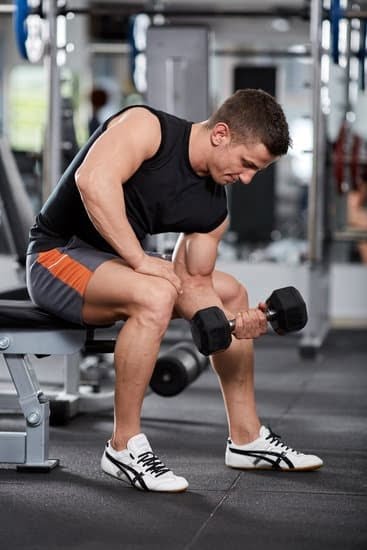How to be fit without doing exercise may sound like an impossible feat, but it is indeed achievable with the right approach. In this article, we will explore the concept of staying fit without traditional exercise and delve into various alternative methods that contribute to overall fitness. From mindful eating to stress management and quality sleep, there are numerous ways to maintain a healthy lifestyle without hitting the gym regularly.
In today’s fast-paced world, many individuals struggle to find time for regular exercise or simply may not enjoy traditional workouts. However, being fit encompasses more than just physical activity, and this article will uncover the various components that contribute to overall health and fitness.
By understanding the role of nutrition, movement, stress management, quality sleep, muscle building, daily habits, motivation, and mindset in staying fit without exercising, readers will gain insight into alternative approaches to maintaining their well-being.
As we embark on this exploration of non-traditional fitness methods, it’s important to keep an open mind and consider new perspectives on what it means to be fit. By incorporating the principles discussed in this article into your daily life, you can achieve a level of fitness and well-being that doesn’t necessarily rely solely on conventional exercise routines.
So let’s delve into the different aspects of staying fit without traditional exercise and discover how small changes can make a big impact on our overall health.
Mindful Eating
In today’s fast-paced world, finding time to engage in traditional exercise routines can be challenging. However, maintaining physical fitness doesn’t always have to involve hitting the gym or going for a run. One of the key elements of staying fit without exercising is through mindful eating. Nutrition plays a crucial role in our overall health and well-being, and making conscious food choices can greatly impact our fitness levels.
Here are some ways to practice mindful eating and improve your fitness without necessarily engaging in exercise:
- Eat whole foods: Incorporate plenty of fruits, vegetables, lean proteins, and whole grains into your diet. These foods provide essential nutrients that support your body’s functioning and help maintain a healthy weight.
- Pay attention to portion sizes: Be mindful of serving sizes and listen to your body’s hunger cues. Learning to eat in moderation can prevent overeating and support weight management.
- Stay hydrated: Drink an adequate amount of water throughout the day to keep your body functioning optimally. Dehydration can negatively impact energy levels and overall health.
By focusing on nourishing your body with wholesome foods and adopting mindful eating habits, you can contribute to your overall fitness without relying solely on exercise.
In addition to nutrition, it’s important to consider other lifestyle factors that contribute to fitness such as managing stress, getting quality sleep, building muscle tone, incorporating movement throughout the day, adopting daily habits that promote health and wellness, finding motivation outside of the gym, and shifting perspectives on what it means to be fit. By taking a comprehensive approach to health and wellness, you can achieve fitness goals without strictly adhering to traditional exercise routines.
Incorporating Movement
Take the Stairs
One simple way to increase your daily activity is by opting for the stairs instead of the elevator or escalator. Climbing stairs provides a great cardiovascular workout and helps tone muscles in the lower body. Whether at work, at home, or out running errands, choosing to take the stairs whenever possible can add valuable movement to your day.
Desk Exercises
If you have a desk job that requires long hours of sitting, incorporating simple exercises into your workday can help combat the sedentary nature of office life. Leg lifts, seated leg extensions, and shoulder shrugs are just a few examples of exercises that can be performed discreetly at your desk. These movements can help improve circulation and prevent stiffness caused by prolonged periods of sitting.
Active Commuting
Another way to incorporate movement is by choosing active modes of transportation when possible. Walking or biking to work not only reduces carbon emissions but also provides an opportunity for physical activity.
If walking or biking the entire way isn’t feasible, consider partaking in “active commuting” where you park farther away from your destination or get off public transportation a few stops early and walk the rest of the way. This approach allows you to squeeze in extra steps and physical activity throughout the day without dedicating specific workout time.
By finding creative ways to stay active throughout the day, you can achieve fitness goals without traditional exercise routines while making healthy choices that contribute to overall wellness.
Stress Management
Stress has a significant impact on physical health, and it can affect our overall fitness in various ways. When we are stressed, our bodies release cortisol, the stress hormone, which can lead to weight gain, particularly around the abdomen. High levels of cortisol can also increase appetite and cravings for unhealthy foods, leading to poor nutrition choices. Additionally, chronic stress can weaken the immune system, making us more susceptible to illnesses that can hinder our ability to stay fit.
To manage stress effectively and maintain fitness without traditional exercise, it is essential to incorporate stress-relieving practices into everyday life. Mindfulness meditation, deep breathing exercises, and yoga are all effective tools for reducing stress levels and promoting overall well-being. These practices not only have a calming effect on the mind but also help lower cortisol levels in the body.
Another way to manage stress and improve physical health is through regular socialization and spending time with loved ones. Engaging in enjoyable activities with friends and family can release feel-good hormones like oxytocin and dopamine, which counteract the effects of stress hormones. By prioritizing social connections and maintaining a support system, individuals can better manage their stress levels and improve their physical well-being.
| Impact of Stress | How to Manage It |
|---|---|
| Weight gain, increased appetite | Mindfulness meditation, deep breathing exercises |
| Weakened immune system | Regular socialization, spending time with loved ones |
Quality Sleep
When it comes to staying fit without traditional exercise, the role of quality sleep cannot be underestimated. Getting enough sleep is essential for overall health and fitness, as it allows the body to rest and recover, and plays a crucial role in various bodily functions such as metabolism, hormone regulation, and immune system function. Here are some tips on how to prioritize quality sleep for maintaining overall health and fitness:
- Establish a consistent sleep schedule: Going to bed and waking up at the same time every day helps regulate your body’s internal clock, promoting better sleep quality.
- Create a relaxing bedtime routine: Engaging in calming activities before bed, such as reading or taking a warm bath, can signal to your body that it’s time to wind down and prepare for sleep.
- Make your sleeping environment conducive to rest: Keep your bedroom cool, dark, and quiet to create an optimal sleeping environment. Investing in a comfortable mattress and pillows can also make a significant difference in the quality of your sleep.
Furthermore, prioritizing quality sleep not only contributes to physical health but also has a direct impact on mental well-being. Lack of sleep can lead to increased stress levels, decreased cognitive function, mood disturbances, and even weight gain. Therefore, making sleep a priority is crucial for those looking to maintain overall health and fitness without engaging in traditional exercise routines.
Building Muscle
When it comes to building muscle tone without traditional workouts, it’s important to focus on daily activities that engage your muscles. Simple practices like taking the stairs instead of the elevator, gardening, or doing household chores can help you tone and strengthen your muscles. These activities may not feel like conventional exercise, but they can be effective in keeping your muscles engaged and active.
Additionally, incorporating resistance training into your daily routine can also help build muscle tone. This can include using resistance bands during everyday activities or incorporating light weight lifting into your weekly routine. Even simple bodyweight exercises such as squats, lunges, and push-ups can go a long way in helping you build muscle tone without hitting the gym.
Lastly, maintaining a balanced diet that includes an adequate amount of protein can also aid in building muscle tone. Protein is essential for muscle repair and growth, so be sure to incorporate sources of lean protein such as chicken, fish, tofu, and legumes into your meals.
Overall, building muscle tone without traditional workouts is possible by engaging in daily activities that utilize your muscles, incorporating resistance training into your routine, and maintaining a balanced diet with sufficient protein intake.
| Activity | Impact on Building Muscle Tone |
|---|---|
| Taking the stairs | Engages leg muscles and helps strengthen them |
| Resistance training with bands or weights | Aids in muscle toning and strengthening |
| Incorporating bodyweight exercises | Helps tone various muscle groups without traditional workouts |
| Maintaining a balanced diet with protein intake | Essential for muscle repair and growth |
Daily Habits
Hydration and Water Intake
One of the simplest yet most effective daily habits for overall fitness is staying properly hydrated. Drinking an adequate amount of water throughout the day not only supports bodily functions but also helps in regulating appetite, promoting good digestion, and boosting metabolism. By making a conscious effort to drink enough water each day, individuals can improve their overall health and contribute to their fitness without needing to engage in traditional exercise activities.
Active Commuting
Incorporating movement into daily routines can be as easy as choosing active forms of transportation whenever possible. Walking or biking to work, taking the stairs instead of the elevator, and parking farther away from entrances are all simple ways to add more physical activity into a daily routine. These small lifestyle changes may seem insignificant, but over time they can make a noticeable difference in overall fitness levels.
Mental Wellbeing Practices
Wellness isn’t just about physical health – mental wellbeing plays a crucial role in overall fitness as well. Embracing mindfulness techniques such as meditation, deep breathing exercises, and practicing gratitude can help manage stress levels and promote emotional balance. By prioritizing mental wellbeing, individuals can support their physical health without engaging in rigorous exercise routines.
By incorporating these simple lifestyle changes into daily habits, individuals can significantly contribute to their overall fitness without relying solely on structured exercise programs. These small adjustments have the potential to make a big impact on health and wellness over time, offering an alternative approach for those seeking to be fit without doing traditional exercise.
Motivation and Mindset
Many people equate being fit with spending hours at the gym, but it is possible to achieve fitness without traditional exercise. Shifting perspectives on what it means to be fit and finding motivation outside of the gym are crucial aspects of this approach. By making simple lifestyle changes and adopting a different mindset, individuals can improve their overall health and fitness without adhering to strict exercise routines.
One way to shift perspectives on fitness is to focus on overall well-being rather than just physical appearance. This involves embracing a holistic approach that encompasses mental, emotional, and social aspects of health in addition to the physical. By recognizing that fitness is not solely about achieving a specific body type or weight, individuals can cultivate a healthier mindset and find motivation beyond the traditional gym setting.
Finding motivation outside of the gym can involve exploring alternative forms of physical activity that align with personal interests and preferences. Engaging in activities such as hiking, dancing, gardening, or even playing with pets can provide opportunities for movement without feeling like conventional exercise. By incorporating enjoyable activities into daily routines, individuals can stay active and maintain fitness levels without feeling restricted by structured workout regimens.
Additionally, shifting perspectives on fitness also involves recognizing that small daily habits contribute significantly to overall health and well-being. Taking the stairs instead of the elevator, practicing good posture, staying hydrated, and taking regular breaks from sitting can all contribute to improved fitness levels. Embracing these simple lifestyle changes as part of a broader commitment to wellness can help individuals achieve fitness goals without relying solely on traditional exercise.
Conclusion
In conclusion, it is possible to achieve fitness without adhering to strict exercise routines. By focusing on mindful eating, incorporating movement into everyday life, managing stress, prioritizing quality sleep, and building muscle through daily habits, individuals can maintain overall health and wellness without traditional workouts. These alternative approaches to fitness not only provide physical benefits but also contribute to a balanced and fulfilling lifestyle.
It is important to recognize that being fit does not necessarily mean spending hours in the gym or engaging in intense physical activity. Instead, it involves making conscious choices about nutrition, movement, stress management, sleep quality, and muscle building. By embracing these holistic practices, individuals can maintain a healthy weight, reduce the risk of chronic diseases, improve mental well-being, and enhance overall quality of life – all without the need for rigorous exercise regimens.
Ultimately, by shifting perspectives on what it means to be fit and finding motivation outside of the gym, individuals can embark on a fitness journey that aligns with their unique lifestyle and preferences. Whether it’s practicing mindful eating at home or incorporating movement into daily activities such as walking or gardening, there are countless ways to achieve and maintain fitness without doing traditional exercise.
It is essential to remember that small changes add up over time and lead to significant improvements in overall health and well-being.
Frequently Asked Questions
Is It Possible to Be Fit Without Exercising?
It is possible to maintain a level of fitness without traditional exercise by being active in other ways. Activities like walking, taking the stairs, or gardening can contribute to overall fitness.
How Do I Go From No Exercise to Fit?
Going from no exercise to being fit requires starting with small, achievable goals and gradually increasing the intensity and duration of physical activity. It’s important to find activities you enjoy and make them a regular part of your routine.
How Do You Stay Fit if You Can’t Exercise Easily?
If you can’t easily exercise due to physical limitations, staying fit can still be achieved through modified forms of physical activity such as chair exercises, swimming, or yoga. It’s also important to focus on nutrition and maintaining a healthy diet.

Passionate about providing useful information to anyone with an interest in the field of Personal Training, I strive to pass on to our readers quality information and to answer any questions about Personal Trainers, the work they do and how to become one.





